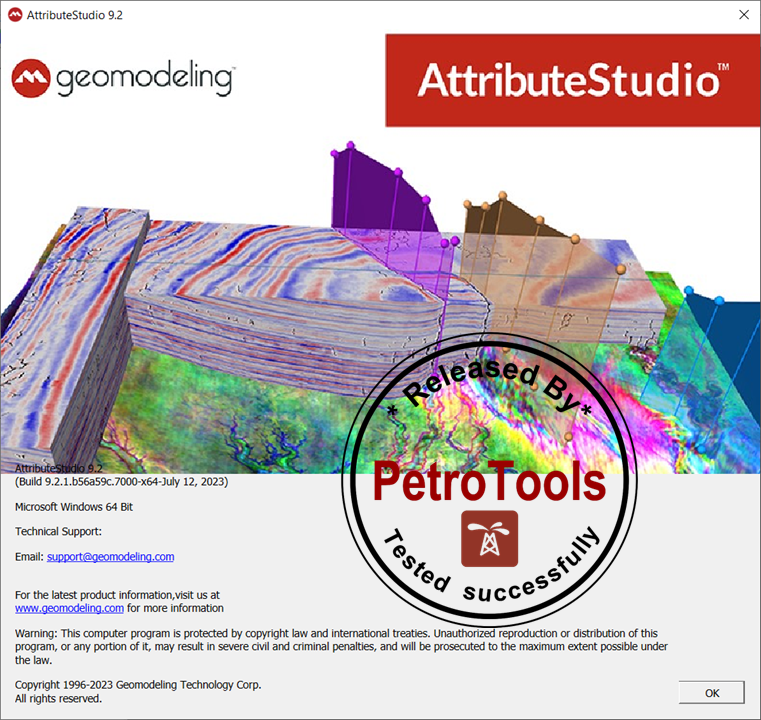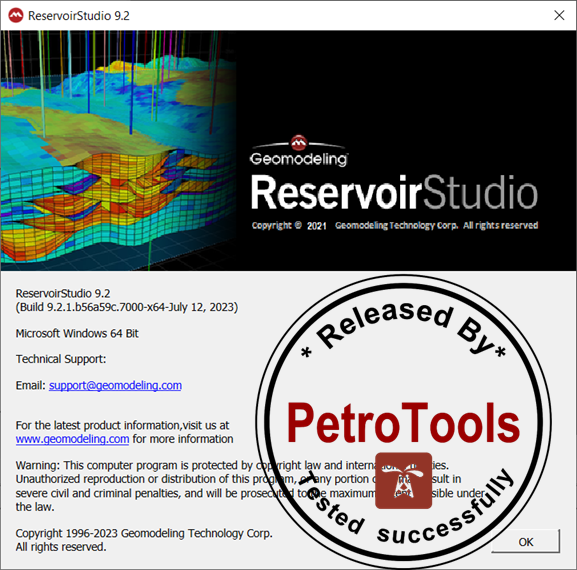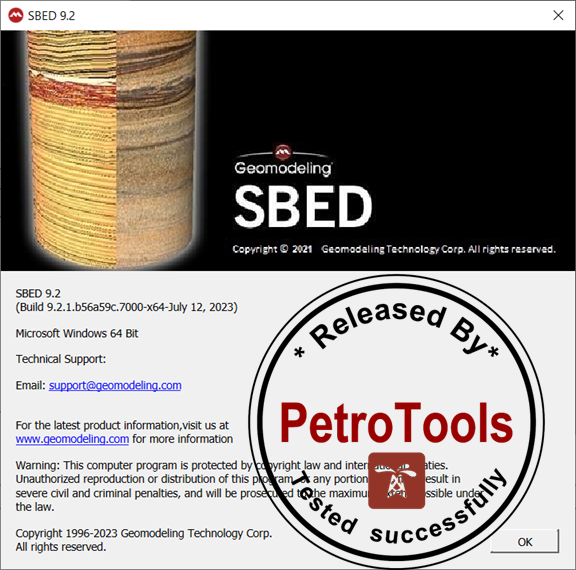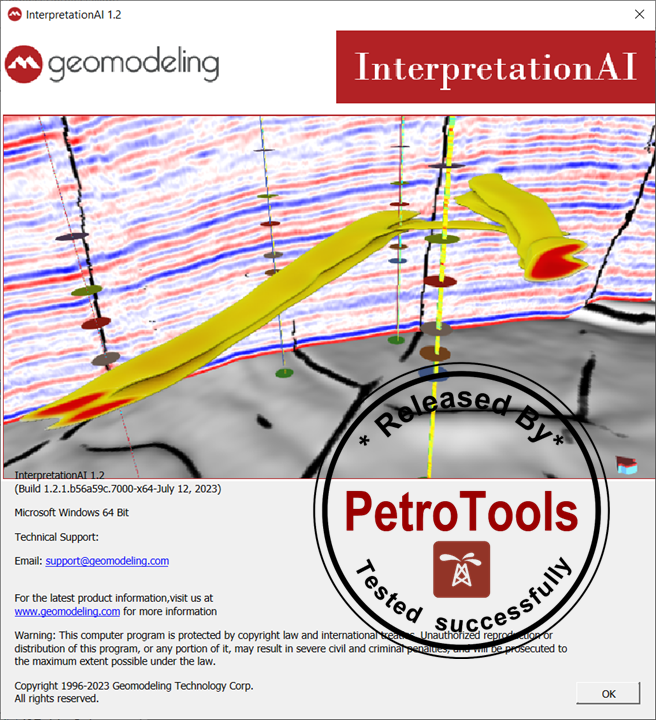مدل سازی زمین شناسی | Geomodeling R2023 9.2

Geomodeling 9.2.1.7000 R2023 is the latest release of an integrated geoscience software system for seismic and well data interpretation, geological modeling, and reservoir property prediction. All geoscience workflows are built inside an Integrated Visualization Environment (IVE) and share the same database. Within the same Geomodeling project, you complete the whole workflows of basic seismic and well log interpretation, reservoir characterization with advanced seismic attribute analysis, and geological modeling with property prediction with the latest machine learning algorithms.
Geomodeling R2023 consists of 16 modules with flexible licenses.
Multi-Scale Shared Database
Integrated Visualization Environment
Well Log Data Analysis and Machine Learning
Geologic Correlation of Well Logs
Formation Property Modeling and Prediction
Core-to-Facies Modeling and Upscaling
Basic Seismic Interpretation Workflow
AI for Seismic Interpretation
Volume Interpretation and Visualization
Seismic Attribute Calculation and Interpretive Processing
Seismic Attribute Analysis
Machine Learning for Integrating Well Data and Seismic Attributes
Geostatistics for Integrating Well Data and Seismic Attributes
Predict Production Potential and Sweet-Spot Mapping
Microseismic Data Analytics and Integration
Static Reservoir Modeling
The above 16 modules, in terms of functionalities, are included into four different products: AttributeStudio, ReservoirStudio, SBED and InterpretationAI. Below table shows the modules included in each product. All products share the same database and integrated visualization environment.

What is AttributeStudio?
AttributeStudio™ is an integrated software system for seismic and well data interpretation and reservoir characterization. Within the same AttributeStudio™ project, you can complete the whole workflows of basic seismic interpretation, integration with well data, and reservoir characterization with advanced seismic attribute analysis, powered by machine learning and deep learning algorithms.
The following is a list of workflows that can be carried out in one AttributeStudio project.
Well log data analysis and quality control
Geologic correlation and well logs and well top picking
Make maps for well tops and well top properties
Tie seismic and well data, with interactive synthetic seismic generation and batch processing.
3-D image enhancement processing and filtering to seismic data before or after calculating seismic attributes.
Calculate single or multi-trace seismic attributes that enhance faults and stratigraphic interpretations.
Pick faults and horizons in 2-D and 3-D seismic surveys.
Extract seismic attributes to strata-grid, interval or horizon for visualization and quantitative attribute analysis.
Build 3-D velocity model and make time-depth conversion.
Predict missing logs with machine learning algorithms.
Calculate elastic modulus logs and elastic modulus volumes from Vp, Vs and density.
Predict reservoir properties from seismic attributes and upscaled well data after training with machine learning algorithms.
Classify seismic attributes into geologic facies with cross-plotting, supervised or un-supervised machine-learning algorithms.
Predict and map production potential in resource plays by integrating well production, drilling, completion, and near-well-bore seismic attributes.
Track and map geobodies from seismic facies or multiple seismic attributes.
Calculate oil and gas in place in reservoir geobodies.
Calculate 3-D and 4-D microseismic volumes to analyze hydraulic fracking process together with completion data.
Estimate SRV for per stage.
Build deep learning model between SRV and completion data to optimize the completion parameters.
Design new well trajectories in 3-D or seismic section windows
Predict microseismic event density maps or volumes for planned wells from deep learning models trained from existing microseismic data.
Print base maps, seismic sections, or make composite plots.
You can carry out above workflows interactively in a user-friendly visualization environment that consists of 3-D, base map, and section windows. All interpretation and integration results from the machine-learning workflows can be visualized immediately in multiple windows for quality controls. AttributeStudio™ supports industrial standard file formats of geotechnical data in data I/O.

ReservoirStudio
ReservoirStudio (RS) provides advanced geologic modeling capabilities for complex depositional environments. With its unique sedimentary process oriented modeling. It generates high resolution reservoir model with greater stratigraphic detail than conventional geocellular models. With built-in sedimentological rules, ReservoirStudio is able to produce realistic geologic models which are beyond the capability of conventional applications.
ReservoirStudio generates geologically accurate models for more realistic reservoir simulations and uncertainty estimates. It models the internal stratigraphic layering and lithofacies relationship observed in depositional environments such as accretionary channel infill, channel levee, turbidity channel and lobe complexes. By modeling stratigraphic features observed below the scale of seismic resolution, AttributeStudio incorporates the effect of small scale geological heterogeneity of fluid flow.
ReservoirStudio is designed to work with the conventional reservoir modeling workflow by adding more stratigraphic detail in the framework grids that are made from seismic and well data. It uses geological rules to model the details of channel infill, channel levee, channel lobe and background sediment as stratigraphic grids. Litho-objects such as mud, sand, and silt can be simulated within stratigraphic grids, along with their corresponding facies proportions. The resulting grid and property models are more realistic, enabling improved accuracy in reservoir performance prediction. By including barriers to fluid flow such as boundary layer mud and channel abandonment facies in the range of possible scenarios, ReservoirStudio becomes an important addition to risk assessment workflow.

SBED delivers effective directional permeability to condition any reservoir property models
SBED™ is a unique software solution to bridge the gaps between core data and full-field reservoir models. With SBED derived Kv/Kh, Kx, Ky, Kz and relative permeabilities, you get more accurate permeability models beyond the conventional workflow, making your reservoir simulation match production history faster and more accurate.
Models sub-well log scale geological details i.e., thin beds, mud drapes, bioturbation, breccia and quantifies their impact on fluid flow properties
Ready with a versatile and accurate numerical solver to model single and two-phase fluid flow
SBED results help improve reservoir simulation accuracy
SBED operates in a cross-scale, shared earth modeling, interpretation, and visualization environment for geoscientists. Its components are:
data management
controls
interpretation and modeling tasks
visualization windows

InterpretationAI
InterpretationAI is a new generation of seismic interpretation software platform, powered by face-recognition-like artificial intelligence (AI) algorithms. With InterpretationAI, a seismic interpreter can complete the work in less than 10% the time required with the traditional seismic software. InterpretationAI provides an innovative yet familiar workflow solution to complete the seismic interpretation tasks:
Fault interpretation
Seismic sequence and horizon interpretation
Channel detection
Geobody and volcano detection
Seismic facies classification
تیم PetroTools آخرین نسخه این نرم افزار را برای شما ارائه می دهد. جهت تهیه نرم افزار با استفاده از منوی خرید با ما در تماس باشید
For buy software, Please contact us via buy menu



 O-Sense
O-Sense
